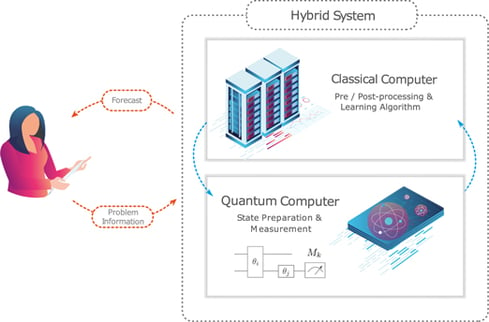Introduction to Quantum Computing
A Parameterized Quantum Circuit (PQC) is a quantum circuit that takes all the data it requires as input parameters. These parameterized quantum circuits can be regarded as machine learning models with remarkable expressive power.
"Parameterized quantum circuits (PQCs) offer a concrete way to implement algorithms and demonstrate quantum supremacy in the NISQ era. PQCs are typically composed of fixed gates (e.g. controlled NOT gates), and adjustable gates (e.g. qubit rotations)." PQCs are relatively small and short-lived. Thus, the main approach consists of formalizing problems of interest as variational optimization problems and then using hybrid systems of quantum and classical hardware to find approximate solutions.
The following figures are from the Benedetti et.al. (2019) article.

Figure. "High-level depiction of hybrid algorithms used for machine learning. The role of the human is to set up the model using prior information, assess the learning process, and exploit the forecasts. Within the hybrid system, the quantum computer prepares quantum states according to a set of parameters. Using the measurement outcomes, the classical learning algorithm adjusts the parameters in order to minimize an objective function. The updated parameters, now defining a new quantum circuit, are fed back to the quantum hardware in a closed loop."

Figure. "Parameterized quantum circuit (PQC) models can be trained for a variety of machine learning tasks, such as supervised and unsupervised learning, on both classical and quantum data. This figure shows examples from each category. In the top-left panel, the model learns to recognize patterns to classify the classical data. In the top-right panel, the model learns the probability distribution of the training data and can generate new synthetic data accordingly. For supervised learning of quantum data, bottom-left panel, the model assists the compilation of a high-level algorithm to low-level gates. Finally, for unsupervised learning of quantum data, bottom-right panel, the model performs lossy compression of a quantum state."
References:
- How do I use parameterized circuits in Qiskit?:
https://www.youtube.com/watch?v=adeYx7bwYrA - Hands-On Quantum Machine Learning With Python:
https://www.pyqml.com/ - Parameterized quantum circuits as machine learning models, Marcello Benedetti, et. al., (2019) Quantum Science and Technology, Vol 4
https://doi.org/10.1088/2058-9565/ab4eb5 - Basic Qiskit Syntax:
https://qiskit.org/textbook/ch-appendix/qiskit.html - Learn in Qiskit:
https://qiskit.org/learn/ - Qiskit:
https://qiskit.org - Qiskit Documentation:
https://qiskit.org/documentation/index.html
